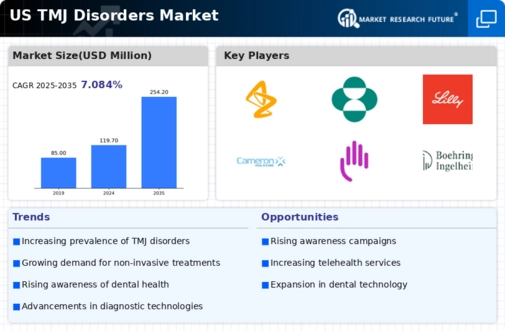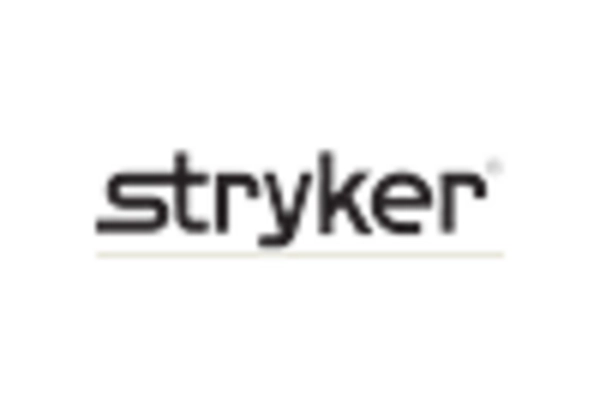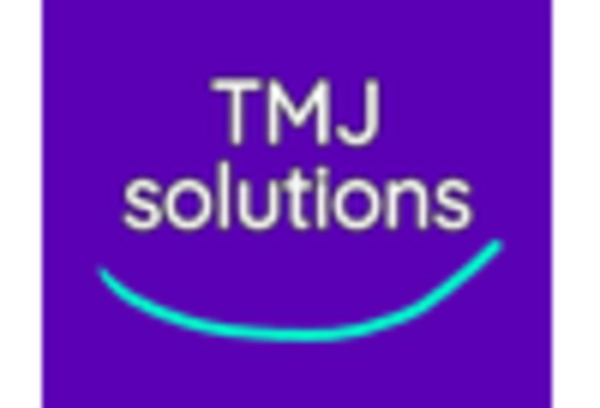Increased Focus on Mental Health
The recognition of the link between mental health and TMJ disorders is emerging as a key driver in the tmj disorders market. Stress and anxiety are known contributors to TMJ dysfunction, prompting a holistic approach to treatment. Mental health professionals are increasingly collaborating with dental practitioners to provide comprehensive care. This integration is likely to enhance treatment outcomes and patient satisfaction. As mental health awareness continues to rise, the demand for integrated treatment plans that address both physical and psychological aspects of TMJ disorders is expected to grow. Consequently, the TMJ Disorders Market may see a shift towards more interdisciplinary approaches..
Rising Incidence of TMJ Disorders
The increasing prevalence of TMJ disorders in the US is a notable driver for the tmj disorders market. Recent studies indicate that approximately 10-15% of the population experiences some form of TMJ dysfunction, which translates to millions of individuals seeking treatment. This rising incidence is attributed to various factors, including stress, teeth grinding, and jaw injuries. As awareness grows, more patients are likely to seek medical advice, thereby expanding the market. The demand for effective treatment options is expected to surge, prompting healthcare providers to invest in innovative solutions. Consequently, the tmj disorders market is poised for growth as healthcare systems adapt to meet the needs of this expanding patient demographic.
Regulatory Support for TMJ Treatments
Regulatory bodies in the US are increasingly supporting the development and approval of new treatments for TMJ disorders. This support is evident in the streamlined approval processes for innovative therapies and devices aimed at alleviating TMJ symptoms. The Food and Drug Administration (FDA) has been proactive in evaluating new treatment modalities, which encourages investment in research and development. As a result, the TMJ Disorders Market is likely to benefit from a surge in new product offerings., enhancing competition and providing patients with more options. This regulatory environment fosters innovation, potentially leading to improved treatment outcomes and market growth.
Technological Innovations in Treatment
Technological advancements play a crucial role in shaping the tmj disorders market. Innovations such as 3D imaging, computer-aided design, and minimally invasive surgical techniques are revolutionizing the way TMJ disorders are diagnosed and treated. These technologies enhance precision in treatment planning and improve patient outcomes. For instance, the introduction of custom-made splints and orthodontic devices has shown to reduce symptoms effectively. The market for these advanced treatment modalities is projected to grow significantly, with estimates suggesting a compound annual growth rate (CAGR) of around 6-8% over the next few years. As practitioners adopt these technologies, the TMJ Disorders Market is likely to experience a substantial transformation..
Growing Demand for Non-Invasive Treatments
The shift towards non-invasive treatment options is a significant driver in the tmj disorders market. Patients increasingly prefer therapies that minimize surgical intervention, leading to a rise in demand for alternatives such as physical therapy, acupuncture, and oral appliances. This trend is supported by a growing body of evidence suggesting that non-invasive methods can effectively alleviate symptoms and improve quality of life. The market for these treatments is expanding, with projections indicating a potential increase in market share by 20-25% over the next five years. As healthcare providers respond to patient preferences, the tmj disorders market is likely to evolve, emphasizing non-invasive solutions.

















Leave a Comment